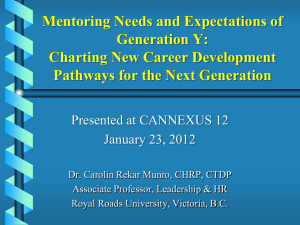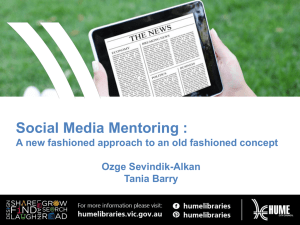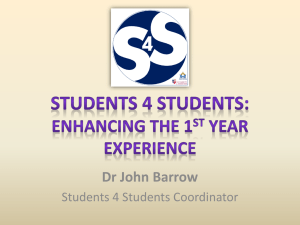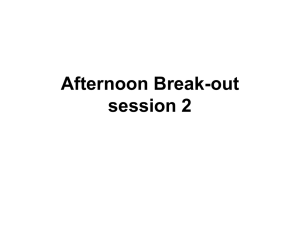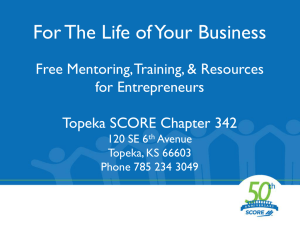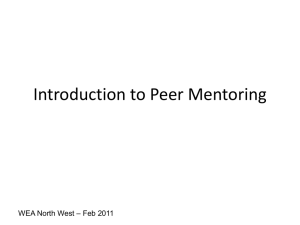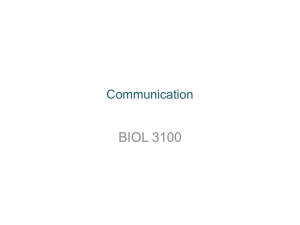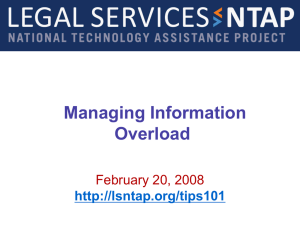PPT(Slides)
advertisement
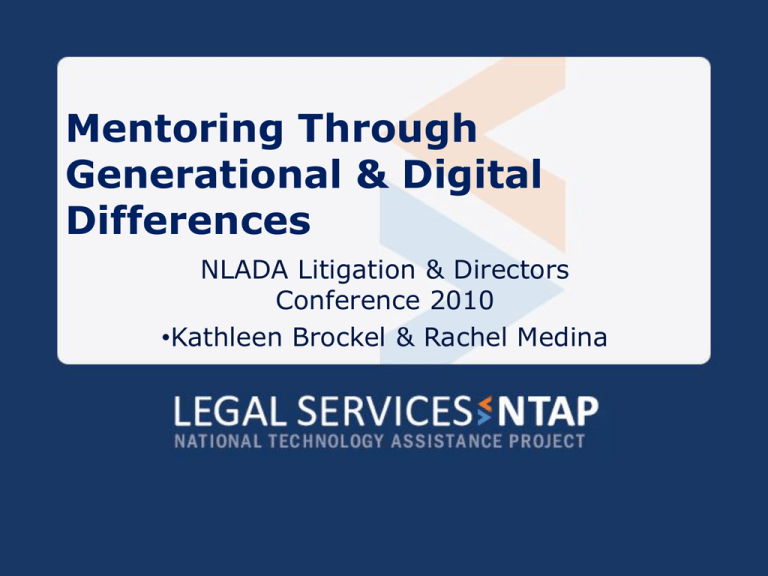
Mentoring Through Generational & Digital Differences NLADA Litigation & Directors Conference 2010 •Kathleen Brockel & Rachel Medina Today’s Discussion ► Mentoring & Reverse Mentoring ► Generational Considerations ► Digital Differences ► Setting up a Reverse Mentoring System Who is LSNTAP and why are we interested in mentoring? What is LSNTAP? ► LSNTAP helps legal services law firms, attorneys, and advocates improve the lives of the most vulnerable people and groups in their communities through the use of technology. ► It is our belief that technology greatly increases the capacity of a non-profit law firm to help more people obtain equal access to justice. What services does LSNTAP offer? ► Training, recommendations, and counsel on technology resources related to service delivery. ► A national perspective on the use and application of technology as tools for improving service delivery and expanding client capacity. What services does LSNTAP offer? (con’t.) ► A progressive approach to advocacy, education, and training on technology issues affecting the legal aid community. ► Facilitates the exchange of information among legal services attorneys, advocates and staff to advance issues of technology and professional development opportunities. Opportunities for Attorneys and Advocates ► Roundtable Discussions ► Legal Aid Tech Library ► Case Management Ratings ► LSTech List ► GIS Mapping ► Web Conferencing ► Online Project Management ► Customized Training ► DLAW Template ► Real-time Collaborations ► Poverty Law Surveys ► Office Suite Tools ► Web 2.0 Tools ► Conference Presentations ► Desktop Utilities ► Consulting Assistance ► Web-based Trainings ► LSNTAP.org ► Help Desk ► Mobile Web Sites Today’s Discussion ► Mentoring & Reverse Mentoring ► Generational Considerations ► Digital Differences ► Setting up a Reverse Mentoring System What is reverse mentoring? Reverse mentoring • is a process by which a person seeks out an "expert" who has less job experience than he/she does, but who holds a wealth of knowledge/skill on a topic that is continually changing and growing. Mutual mentoring Mutual mentoring (reciprocal mentoring) • occurs when each person brings to the table knowledge to teach and a different topic to learn, and they agree to exchange mentor and mentee roles as appropriate. This is a two-way process in which each party gives and gains. How did reverse mentoring start? ► 10 years ago at General Electric 600 Executives CEO Jack Welch Younger Mentors Learn About the Internet! Time Warner College Students Senior Execs Program extended from four pilot cities to larger groups of executives throughLearn About Web 2.0 & Technologies Affecting Media out the company. Deloitte & Touche ► Started reverse mentoring program in 2001 ► Started with Outlook and managing email ► Now extended to offices across the country Wharton Business School Matches executive MBAs with junior mentors who demonstrated an excellent grasp of technology. “Executives are beginning to realize that knowledge isn’t a one-way street. It’s in everyone’s best interest to share expertise,” points Jerry Wind, director of the Wharton program. Face-to-Face E-Mail Skype Proctor & Gamble “It’s a situation where the old ‘fogies’ in an organization realize that by the time you are in your forties and fifties, you are not in touch with the future the same way the young twentysomethings are.” Today’s Discussion ► Mentoring & Reverse Mentoring ► Generational Considerations ► Digital Differences ► Setting up a Reverse Mentoring System 4 - 5 generations in the workplace ► Traditionalists, born prior to 1946 ► Baby Boomers, born between 1946 and 1964 ► Gen X, born between 1965 and 1976 ► Millennials, born between 1977 and 1997 ► Gen 2020, born after 1997 4 Generations ► Traditionalists born 1925-1942 ► Butter Toffee ► Baby Boomers born 1943-1962 ► Smarties ► Generation X born 1963-1978 ► Jawbusters ► Generation Y/Millennials born 1979-1998 ► Lollipops (under age 30 today) What is a generation? ►Defined by the similar formative influences– ►social, ►cultural, ►political, ►economic ►– that existed as the individuals of particular birth cohorts were growing up. Bookend Generations Boomers 1946- 1964 Gen X Gen Y 1979 – 1994 More in common with Gen Y More in common with Boomers (than Xers) Values (work life balance, sabbaticals, “giving back”) Values (work life balance, sabbaticals, “giving back”) Double the size of Gen X Y’s 86% important that their work has positive impact on the world 84% very ambitious 78% comfortable working with diversity of people 48% networking with friends important Top 5 things Millennials/Y’s want to learn in the workplace Technical skills in area of expertise Self management and personal productivity Leadership Industry or functional knowledge Creativity and innovation strategies Boomers 45% project working after age 65 71% report elder care responsibilities 87% work flexibility important 47% see themselves as being in the middle of their careers 55% members of external volunteer networks Rewards at least as important as compensation Gen Y Boomers 1. 2. 3. 4. 5. 1. High quality colleagues 2. Intellectually stimulating workplace 3. Autonomy regarding work tasks 4. Flexible work arrangements 5. Access to new experiences/challenges 6. Giving back to the world through work 7. Company/boss recognition High quality colleagues Flexible work arrangements Prospects for advancement Company/boss recognition Steady advancement/promotion 6. Access to new experiences/challenges Today’s Discussion ► Mentoring & Reverse Mentoring ► Generational Considerations ► Digital Differences ► Setting up a Reverse Mentoring System Generational Digital Differences Digital Natives Digital Settlers Digital Immigrants Digital Natives 46% use phone primarily to make and receive calls, and 39% use phone primarily to send and receive text messages 72% can text blindfolded! (using keyboard) 28% browse the web on their phone 38% somewhat agree, 19% strongly agree (57%) having a cell phone as improved the quality of their life Digital Natives vs. Digital Immigrants Are you a…. • Probably born prior to Internet boom • Fast and eager learner • Intimidated at first with technology • Once you learn a technology you are at ease. Trident Immigrant • Born closely prior to or post Internet availability (‘92) • Most of your life, you’ve had easy access to computers • Not intimidated by digital world • Quick to adapt to new technologies Big Red Settler Native Orbit • You feel a little left behind in the digital world • Fear about using technologies • Prefer to do things the way you are most familiar with • You can eventually adapt Generation/Digital Assessment ► Do you have your own web page? (1 point) ► Have you made a web page for someone else? (2 points) ► Do you IM your friends? (1 point) ► Do you text your friends? (2 points) ► Do you watch videos on YouTube? (1 point) ► Do you remix video files from the Internet? (2 points) ► Have you paid for and downloaded music from the Internet? (1 point) ► Do you know where to download free (illegal) music from the Internet? (2 points) Generation/Digital Assessment ► Do you blog for professional reasons? (1 point) ► Do you blog as a way to keep an online diary? (2 points) ► Have you visited MySpace at least five times? (1 point) ► Do you communicate with friends on Facebook? (2 points) ► Do you use email to communicate with your parents? (1 point) ► Did you text to communicate with your parents? (2 points) ► Do you take photos with your phone? (1 point) ► Do you share your photos from your phone with your friends? (2 points) Answers to the Quiz ►0 - 1point – Baby Boomer ►2-6 points – Generation Jones ►6- 12 points – Generation X ►12 or over – Generation Y ► How many guessed their profile “correctly”? ► Is the media use quiz valid? ► For those that answered “no” – ► Did you overestimate or underestimate your generational/digital competence? ► What made the quiz invalid? ► What are the generations in your office? ► How would you classify your program and staff positions? (Who are the natives? Immigrants? settlers?) ► Has this diversity caused challenges related to technology change … how have those been addressed in your office? ED’s: Staff Attorneys 70 White Males 668 White Males 26 White Females 1279 White Females 10 Black Males 61 Black Males 10 Black Females 250 Black Females 5 Hispanic Males 107 Hispanic Males 6 Hispanic Females 218 Hispanic Females 2 N.A. Males 5 N.A. Males 3 N.A. Females 24 N.A. Females 2 AsianPac Males 36 AsianPac Males 1 AsianPac Female 113 AsianPac Females Today’s Discussion ► Mentoring & Reverse Mentoring ► Generational Considerations ► Digital Differences ► Setting up a Reverse Mentoring System Reverse Mentoring Systems in Legal Aid? What programs have “regular” mentoring systems? Used for what goal/purpose? Has anyone been involved with a reverse mentoring program? Why is one-on-one assistance crucial? 1. It is needed when obtaining the knowledge is relevant to immediate work at hand. 2. A higher degree of learning is likely to take place when the material is relevant. 3. People will set up their own informal networks or mentoring scenarios if you don’t. 10 Steps to Set Up the Mentoring Program 1. 2. 3. 4. 5. 6. 7. 8. 9. 10. Define The Purpose Ensure Leadership Engagement Opt in only Advise Mentors To Be Patient With Mentees Training for Mentors Support for Mentors Training for Mentees Create a Solid and Specific Program Appropriate Pairing Have Fun! Mentoring Cycle Preparation Closure Establish agreements Enabling Goals & Purpose Examples for reverse mentoring: ► Learn how to complete a HotDocs form and edit it. ► Learn to handle Live Chat responses on client website. ► Learn court’s electronic filing system. ► Others? Mutual Mentoring Goals Y mentors Boomer on project management software Boomer mentors Y on foreclosure litigation strategy More Formal = Agreement or Contract Goals of the relationship what mentee wants to learn. Ground rules how often and in what manner communications and meetings will occur. Boundaries on the relationship What is to be treated as confidential information what topics or issues are not to be dealt with. Pairing “ ‘As a researcher, I can tell you that how you best match people is probably the issue where we know the least about,’ says Tammy Allen, a professor of psychology, University of South Florida and co-author of Designing Workplace Mentoring Programs: An EvidenceBased Approach." Pairing Suggestions: Have mentors & mentees complete information sheets on what they hope to offer & obtain. Use a committee to pair people Offer mentors & mentees several partner options and have them choose. Once paired, enable opportunity for mentor & mentee to get together informally. Set up a check-up (“it’s nothing personal”). Factors Contributing to Successful Mentoring Partnership Clear and respectful communication Openness Trust Genuine interest Risk-taking and managing fear of failure Clear and realistic goals and priorities Focus Commitment Feedback Support for Mentors & Mentees ► How about a support group to discuss difficulties mentors are experiencing? ► What tech tools could assist the process? ► What are reasonable progress expectations? Training for Mentors and Mentees ► Discuss generational differences & assumptions. ► Discuss methods for mentor teaching the mentee. ► Discuss methods for mentee to communicate to mentor. Resources – Learning Styles ► Learning Style Self-Assessments: ► http://bit.ly/G0tiD -- This quiz sorts out learners who prefer written, oral or hands-on learning ► http://bit.ly/RgZFW -- Sorts preferred styles into visual, auditory and Tactile/Kinsethetic Evaluating Ask participants how their experiences went. Look at measureable improvement. Look at job satisfaction levels, productivity, etc. Will you try a reverse mentoring or mutual mentoring program? THANK YOU Visit www.lsntap.org for slides! Kathleen Brockel kathleen@lsntap.org Rachel Medina rachel@lsntap.org

